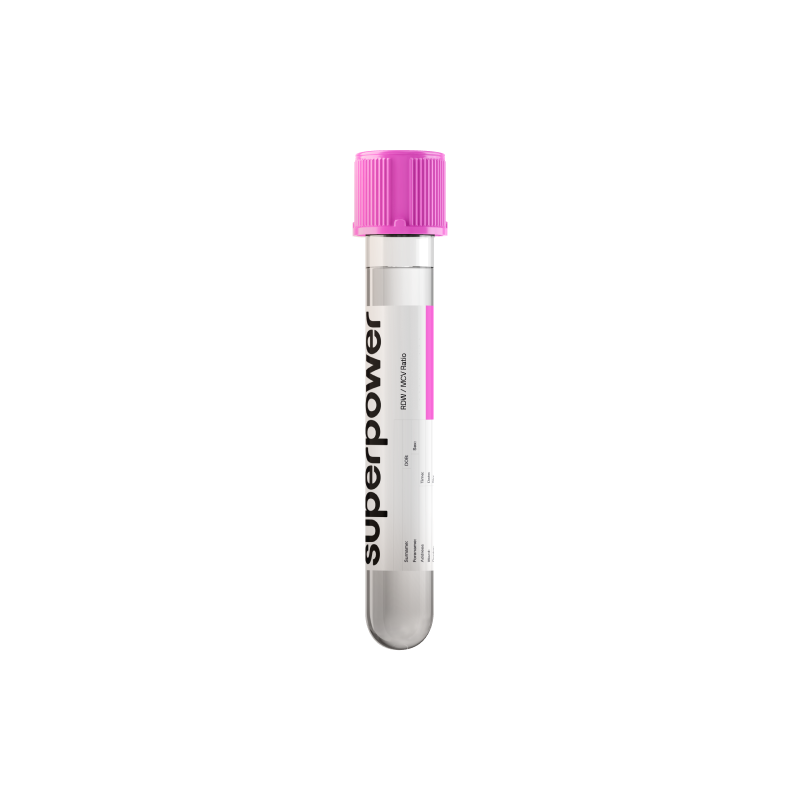The RDW / MCV Ratio is calculated by dividing red cell distribution width (RDW) by mean corpuscular volume (MCV). RDW measures variation in cell size; MCV measures the average cell size. A higher ratio reflects more variability and/or smaller average cells, often linked to iron deficiency or mixed nutrient deficits.
A lower ratio reflects uniform, often larger cells, seen in macrocytosis. This ratio adds nuance to a standard CBC, clarifying red cell quality and revealing subtle morphology shifts that hemoglobin alone can miss.
Key Benefits
- Spot red blood cell size imbalance to flag likely anemia type early.
- Spot likely iron deficiency when the ratio is high with low MCV.
- Flag possible B12 or folate lack when ratio rises with high MCV.
- Clarify thalassemia trait when RDW stays normal but MCV is very low.
- Explain fatigue, breathlessness, or hair loss by uncovering iron-related red cell changes.
- Guide treatment choices by pointing toward iron versus B12 or folate replacement.
- Protect fertility and pregnancy by flagging iron deficiency before complications develop.
- Track recovery as RDW and MCV normalize with effective therapy over weeks.
What is RDW / MCV Ratio?
The RDW/MCV ratio is a calculated index from two common complete blood count measures: RDW and MCV. RDW describes how much red blood cell sizes vary (anisocytosis); MCV is the average cell size (mean corpuscular volume). Dividing size spread by average size normalizes variability to the typical cell, and it comes straight from the same blood sample.
It summarizes the red cell population by showing how uneven sizes are relative to their mean. This normalized spread reflects mixtures of differently matured cells from the bone marrow (erythropoiesis) and differences in hemoglobin filling (hemoglobinization). Anchoring variability to average size helps separate true size diversity from changes that simply mirror overall larger or smaller cells. In essence, it is a compact descriptor of red cell size heterogeneity scaled to the population’s mean and the steadiness of red cell production.
Why is RDW / MCV Ratio important?
The RDW/MCV ratio compares how varied your red blood cell sizes are (RDW) to their average size (MCV). It’s a snapshot of bone‑marrow output and nutrient supply—iron, B12, folate—showing how well your blood can carry oxygen to the heart, brain, and muscles. When red cells are made smoothly and evenly, this ratio sits in a narrow, mid‑range band.
When the ratio trends lower, it often means cells are larger with relatively little size spread—macrocytosis without marked anisocytosis. Physiologically, that points to slowed DNA synthesis from B12 or folate deficiency, alcohol‑ or liver‑related changes, or hypothyroidism, where MCV rises before RDW widens, pulling the ratio down. People may feel fatigue, reduced exercise tolerance, and (with B12 lack) numbness or memory changes; pregnancy increases folate/B12 demand, and older adults more often show thyroid or liver causes.
When the ratio is higher, variability dominates relative to average size. This is typical of early iron deficiency, chronic or occult blood loss, or recovery from bleeding, when small, older cells mix with larger young cells before MCV fully shifts. Fatigue, shortness of breath, headaches, palpitations, and restless legs are common; in children it can affect learning and growth, and in pregnancy it reflects rising iron needs. Mixed deficiencies (iron with B12/folate) also push the ratio up even if MCV looks near normal.
Big picture: This ratio links marrow kinetics, iron trafficking, and thyroid/liver status. Interpreted with hemoglobin, ferritin, and other indices, it helps differentiate iron deficiency, macrocytosis, mixed anemia, and anemia of inflammation—clarifying causes with implications for cardiovascular strain, neurocognition, and pregnancy outcomes.
What Insights Will I Get?
What RDW / MCV Ratio tells you
The RDW/MCV ratio compares variability in red cell size (RDW) to their average size (MCV). It reflects steadiness of marrow production, iron handling, and cell maturation. Because red cells drive oxygen delivery and blood flow, the ratio relates to energy, cognition, pregnancy demands, and cardiovascular risk. It helps interpret RDW across microcytosis or macrocytosis and can reveal early imbalance.
Low values usually reflect uniform cell sizes and/or larger average cells. This often signals stable erythropoiesis with adequate iron and minimal inflammatory blockade. If driven by high MCV, it can accompany macrocytosis from low B12 or folate, alcohol, liver disease, or too little thyroid hormone (hypothyroxinemia). Pregnancy may mildly raise MCV, lowering the ratio without disease.
Being in range suggests balanced marrow output, matched iron availability, and efficient oxygen transport and flow. Optimal often lies mid‑range, but cutoffs are not standardized.
High values usually reflect greater size dispersion and/or smaller average cells. This points to iron‑limited production, recent blood loss, inflammation with hepcidin‑mediated iron trapping, or recovery from anemia with many young cells (reticulocytosis). Mixed deficiencies (iron plus B12/folate) can raise it further. Children and pregnancy, with higher iron demand, show this more often; older adults with chronic disease may too.
Notes: Interpret with hemoglobin, RDW, MCV, reticulocytes, and iron studies, since the ratio lacks universal reference ranges. Acute illness, transfusion, altitude, certain drugs, renal or thyroid disease, and timing relative to therapy can shift it; values evolve over weeks as new cells appear.



.svg)



.png)
.png)
.png)
.png)








